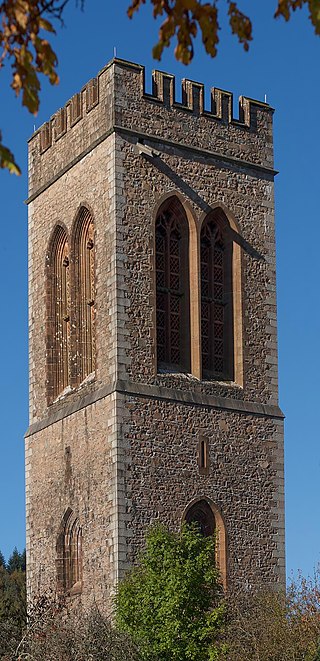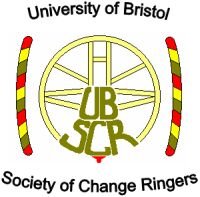
Change ringing is the art of ringing a set of tuned bells in a tightly controlled manner to produce precise variations in their successive striking sequences, known as "changes". This can be by method ringing in which the ringers commit to memory the rules for generating each change, or by call changes, where the ringers are instructed how to generate each change by instructions from a conductor. This creates a form of bell music which cannot be discerned as a conventional melody, but is a series of mathematical sequences.

The Whitechapel Bell Foundry was a business in the London Borough of Tower Hamlets. At the time of the closure of its Whitechapel premises, it was the oldest manufacturing company in Great Britain. The bell foundry primarily made church bells and their fittings and accessories, although it also provided single tolling bells, carillon bells and handbells. The foundry was notable for being the original manufacturer of the Liberty Bell, a famous symbol of American independence, and for re-casting Big Ben, which rings from the north clock tower at the Houses of Parliament in London.

John Taylor Bell Foundry (Loughborough) Limited, trading as John Taylor & Co and commonly known as Taylor's Bell Foundry, Taylor's of Loughborough, or simply Taylor's, is the world's largest working bell foundry. It is located in Loughborough, in the Charnwood borough of Leicestershire, England. The business originated in the 14th century, and the Taylor family took over in 1784.

The Cathedral Church of St. James is an Anglican cathedral in Downtown Toronto, Ontario, Canada. It is the location of the oldest congregation in the city, with the parish being established in 1797. The cathedral, with construction beginning in 1850 and opening for services on June 19, 1853, was one of the largest buildings in the city at that time. It was designed by Frederick William Cumberland and is a prime example of Gothic Revival architecture.

St Leonard's, Shoreditch, is the ancient parish church of Shoreditch, often known simply as Shoreditch Church. It is located at the intersection of Shoreditch High Street with Hackney Road, within the London Borough of Hackney in East London. The current building dates from about 1740 and is Grade I listed. The church is mentioned in the line ""When I grow rich", say the bells of Shoreditch" from the nursery rhyme Oranges and Lemons.
The Oxford University Society of Change Ringers, founded in 1872, is the official society dedicated to change ringing in Oxford University. Its objects are to promote the art of change ringing in the university and to ring for Sunday services in Oxford during full term.

The Nottingham University Society of Change Ringers (NUSCR) is one of the oldest societies affiliated to the University of Nottingham Students' Union, being founded in 1958. Its principal aim is to allow students from both the University of Nottingham and Nottingham Trent University to practise English Change Ringing. It also represents the University at the annual Northern Universities Association (NUA) Striking Competition each November.
The Ancient Society of College Youths (ASCY) is a change ringing society, founded in 1637 and based in the City of London. The society played a leading role in the early development of change ringing, and today, it provides ringers for important events at St Paul's Cathedral and Westminster Abbey. Although it is a non-territorial association, its importance is recognised through having four representatives on the Central Council of Church Bell Ringers.

The Cathedral of St Michael and St George is the home of the Anglican Diocese of Grahamstown in Makhanda in the Eastern Cape Province of South Africa. It is the episcopal seat of the Bishop of Grahamstown. The cathedral is located on Church Square and has the tallest spire in South Africa 176 feet (54 m). The cathedral is dedicated to St Michael and St George and celebrates its patronal festival on the Sunday closest to Michaelmas.
Events from the year 1844 in the United Kingdom.
Fabian Stedman (1640–1713) was an English author and a leading figure in the early history of campanology, particularly in the field of method ringing. He had a key role in publishing two books Tintinnalogia and Campanalogia which are the first two publications on the subject. He is also regarded as being a pioneer in the branch of mathematics known as Group theory.
John Holt was a leading change ringer and noted composer of peals on English full circle bells in the 18th century, and is described as a composer "..holding a position which is unique in the history of change ringing".
The Central Council of Church Bell Ringers (CCCBR) is an organisation founded in 1891 which represents ringers of church bells in the English style.
The Guild of St Magnus is a bell ringing guild formed in 2009, following the new installation of the bells at St Magnus-the-Martyr, with the main aim of ringing for Sunday services at St Magnus the Martyr. Guild members are often also members of other guilds and societies in London and support other bands of ringers including: Southwark Cathedral; St Martin-in-the-Fields; St Michael, Cornhill and St Olave Hart Street.
The Royal Jubilee Bells are a set of eight bells that were cast for the church of St James Garlickhythe in the City of London, which were seen on television around the world leading the Thames Diamond Jubilee Pageant on 3 June 2012 for the Diamond Jubilee of Elizabeth II.

Frances Evelyn "Fanny" Boscawen was an English literary hostess, correspondent and member of the Blue Stockings Society. She was born Frances Evelyn Glanville on 23 July 1719 at St Clere, Kemsing, Kent. In 1742 she married Admiral The Hon. Edward Boscawen (1711–1761). When his navy work took him away from home, his wife would send him passages from her journal, some of which were later published.

A peal board records on a wooden, metal, stone or canvas plaque a peal rung on church bells.

The Duke's Tower, also known as Inveraray Bell Tower, is the detached bell tower of All Saints' Church, Inveraray, Argyll and Bute, Scotland. Standing 126 feet (38 m) high on the shores of Loch Fyne, it is a landmark for miles and amongst the most notable bell towers in the United Kingdom. The tower was built as a memorial to members of the Clan Campbell who died in the First World War. It is Grade A listed by Historic Environment Scotland, the highest possible rating.
Campanology is the scientific and musical study of bells. It encompasses the technology of bells – how they are cast, tuned, and rung – as well as the history, methods, and traditions of bellringing as an art. Articles related to campanology include:











